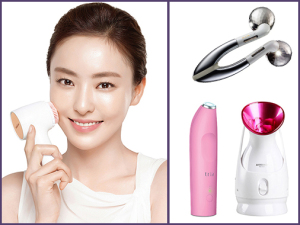High returns are rewarded to the majority of at-home beauty device firms that had the foresight to enter Asia, finds Kline’s just published Asia reports on China, Japan, and South Korea from Beauty Devices: Global Market Analysis and Opportunities. Asia’s sales growth for the beauty devices market outpaces the United States and Europe, growing much higher than the industry average, increasing by over 29% in 2014.
New product launches are plentiful throughout the region, helping to fuel overall sales growth. A large number of the newly launched devices in China target skin cleansing. For instance, Kingdom, a leading local brand, launches a popular heat-based cleansing device in spring 2014. In Japan, MTG launches its new ReFa ACTIVE, while YA-MAN expands its portfolio by launching new devices targeting hair removal and anti-aging. Philips introduces its first cleansing device for men called VisaPure Men in South Korea in 2014.
Local marketers expand their distribution channels, with some going beyond traditional outlets by entering fitness facilities. Leading local player MTG diversifies its distribution through entering television home shopping in South Korea. In China, many global marketers expand their distribution into prestige outlets where sales grow at the highest rate among all channels, by almost 60% in 2014. Local marketers often opt for partnering with tmall.com or lotte.com, key online platforms in China and South Korea.
Established skin care brands launch devices to compete with electronic beauty gadgets and increase the efficiency of their existing skin care lines. AmorePacific introduces MakeON cleansing products in South Korea, and Dr. Ci:Labo launches the anti-aging device Sonic Lift Special in Japan. On the other end of the spectrum, beauty device brands begin launching topical skin care products to sell together with devices.
“Each market in Asia carries its own nuances,” comments Prashant Sharma, Project Manager for the report series at Kline. “In terms of sales of devices by skin care concern, the differences are dramatic, with anti-aging being a key concern in South Korea, cleansing in China, and hair removal in Japan. However, with the entrance of new global players to these markets and the introduction of a variety of new products, this landscape is changing. For example, the cleansing segment in South Korea nearly triples in size in 2014. The changes are remarkable and vary from one region to another.”
The local brands in Asia represent sustainable competition to multinationals. Many have been introducing enticing new products. For instance, in South Korea, local companies such as Eyesel Creative and Pobling are filling the void of the lower-end price segment to target younger consumers, such as students. This resonates well with the U.S. introduction of the first lower-priced product by La Lumiere, illuMask introduced in 2014.
At the recent CEW West Coast event, Kline’s Director, Karen Doskow, was a key presenter and a guide through the beauty devices world, joined by Marina Randolph, CMO of La Lumiere, and Paul Peros, founder of Swedish-based Foreo. At their panel discussion, Randolph explained how their illuMask brand opens up an entire new audience with its under $30.00 price point. Dermalogica founder and owner Jane Wurand, who moderated the event, likened Peros’ Foreo Luna cleansing brush to “the Apple of the cleansing device world.”
Learn more about the at-home beauty devices market in Asia from Kline’s Beauty Devices: Global Market Analysis and Opportunities, the first to assess the market for power-operated skin care products for home use

